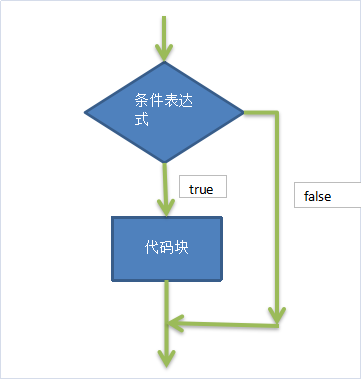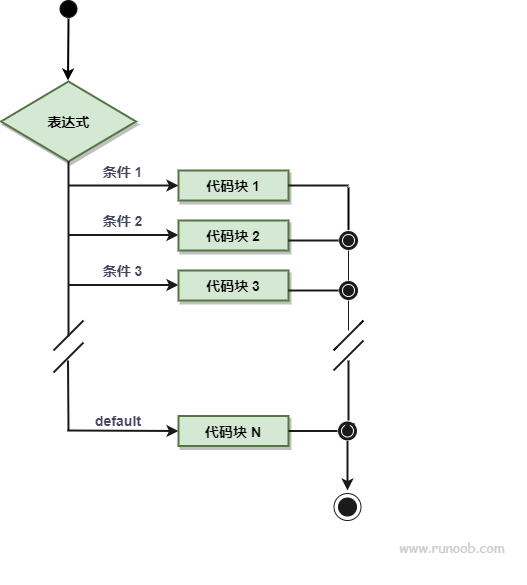Go语言的条件语句
一、if语句
基本语法:
if 条件表达式 {
执行语句块
}
说明:当条件表达式为true时,就会执行{}里的代码
注意:{}时必须有的,不能省略,否则编译不通过
执行流程图如下所示:

使用细节:if还有一个强大的地方就是条件表达式那里允许声明一个变量,这个变量的作用域只在该条件逻辑块内,其他地方不起作用。
例子:
package main
import "fmt"
func main() {
if age := 10; age > 9 {
fmt.Println("Hello, World!")
}
}
二、if-else语句
基本语法
if 条件表达式 {
执行代码块1
} else {
执行代码块2
}
说明:当条件表达式为true时,执行代码块1,否则执行代码块2
执行流程图如下所示:

例子:
package main
import "fmt"
func main() {
if age := 19; age > 18 {
fmt.Println("年龄大于18岁")
} else {
fmt.Println("年龄小于18岁")
}
}
三、if-else if-...=else
基本语法:
if 条件表达式1 {
执行代码块1
} else if 条件表达式2 {
执行代码块2
}
...
esle {
执行代码块n
}
说明:先判断表达式1,若为true则执行代码块1,否则判断表达2,若表达式2位true,则执行代码块2,否则以此类推,若所有表达式都不成立,则执行代码块n。
使用细节:
- else不是必须的
- 多分支只能有一个执行入口
执行流程图如下:

package main
import "fmt"
func main() {
if age := 19; age > 18 {
fmt.Println("年龄大于18岁")
} else if age > 15{
fmt.Println("年龄大于15岁")
} else if age > 10 {
fmt.Println("年龄大于10岁")
} else {
fmt.Println("年龄太小")
}
}
输出结果:
年龄大于18岁
四、swich语句
基本语法
switch 表达式 {
case 表达式1,表达式2,...:
代码块1
case 表达式3,表达式4,...:
代码块2
case 表达式4,表达式5,...:
代码块3
default:
代码块n
}
说明:switch 语句用于基于不同条件执行不同动作,每一个 case 分支都是唯一的,从上至下逐一测试,直到匹配为止。
使用细节:
- case后是一个表达式(即:常量值,变量,一个有返回值得函数等都可以)
- case后的各个表达式的值得数据类型,必须和switch的表达式的数据类型一致
- case后的表达式可以为多个,使用逗号分隔。
- case后面的表达式如果是常量值,则要求不能重复
- switch 默认情况下 case 最后自带 break 语句,匹配成功后就不会执行其他 case,如果一个都匹配不到则执行default,如果我们需要执行后面的case,可以使用fallthrough
package main
import "fmt"
func main() {
var mouth byte = 5
switch mouth {
case 1,2,3:
fmt.Println("该月是第一季度")
case 4,5,6 :
fmt.Println("该月是第二季度")
fallthrough // 默认只能穿透一层
case 7,8,9 :
fmt.Println("该月是第三季度")
case 10,11,12 :
fmt.Println("该月是第四季度")
}
}
输出结果
该月是第二季度
该月是第三季度
- default语句是不必须的
- switch后可以不带表达式,类似if-else分支来使用
package main
import "fmt"
func main() {
var mouth byte = 8
switch {
case 1 <= mouth && mouth <4:
fmt.Println("该月是第一季度")
case 4 <= mouth && mouth < 7 :
fmt.Println("该月是第二季度")
case 7 <= mouth && mouth < 10 :
fmt.Println("该月是第三季度")
case 10 <= mouth && mouth <= 12 :
fmt.Println("该月是第四季度")
}
}
输出结果:
该月是第三季度
- switch后也可以声明/定义变量,分号结束
package main
import "fmt"
func main() {
switch mouth := 10; {
case 1 <= mouth && mouth <4:
fmt.Println("该月是第一季度")
case 4 <= mouth && mouth < 7 :
fmt.Println("该月是第二季度")
case 7 <= mouth && mouth < 10 :
fmt.Println("该月是第三季度")
case 10 <= mouth && mouth <= 12 :
fmt.Println("该月是第四季度")
}
}
输出结果
该月是第四季度
9.Type-switch:switch语句还可以被用于type-switch来判断某个interfance变量中实际指向的变量类型
package main
import "fmt"
func main() {
var x interface{}
var y = 10.0
x = y
switch xType := x.(type) {
case nil:
fmt.Printf("x的类型:%T\n",xType)
case int:
fmt.Println("x是int类型")
case float32:
fmt.Println("x是float32类型")
case float64:
fmt.Println("x是float64类型")
case bool:
fmt.Println("x是bool类型")
case string:
fmt.Println("x是string类型")
default:
fmt.Println("未知类型")
}
}
输出结果
x是float64类型
执行流程图:

package main
import "fmt"
func main() {
var mouth byte = 8
switch mouth {
case 1,2,3 :
fmt.Println("第一季度")
case 4,5,6 :
fmt.Println("第二季度")
case 7,8,9 :
fmt.Println("第三季度")
case 10,11,12 :
fmt.Println("第四季度")
}
}
输出结果:
第三季度



